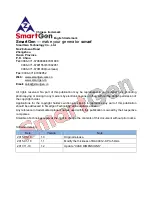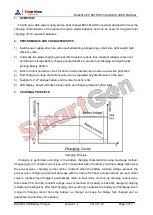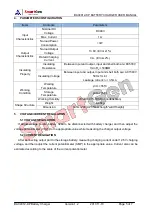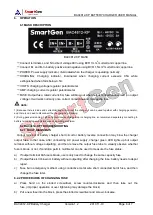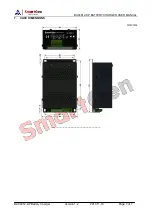
BAC4812-KP BATTERY CHARGER USER MANUAL
BAC4812-KP Battery Charger Version 1.2 2017-11-10 Page 6 of 7
6. OPERATION
6.1 MASK DESCRIPTION
BAC4812-KP MASK
─
Connect terminals L and N to direct voltage 48V using BVR 1mm
2
multi-strand copper line.
─
Connect B+ and B- to battery positive and negative using BVR 1.5mm
2
multi-strand copper line.
─
POWER: Power supply indicator, illuminated when the charger is operating normally.
─
CHARGING: Charging indicator, illuminated when charging current exceeds 0.5A while
extinguished when falls below 0.5A.
─
VOLTS: charging voltage regulator potentiometer
─
AMP: charging current regulator potentiometer
─
FUSE: Output fuse; rated current: 6A; fuse will blow out when output connection reversed (no output
voltage). It will work normally once correct connection and replace the fuse.
NOTE:
1) Because there is diode and current-limiting circuit inner the charger, it can be used together with charging generator,
and there is no need to disconnect the charger when cranking.
2) During genset is running, high current will cause voltage drop in charging line, so recommend separately connecting to
battery terminal to avoid disturbance on sampling precision.
6.2 BAC4812-KP TROUBLESHOOTING
6.2.1 FAULT DIAGNOSIS
Output terminal of battery charger short circuit or battery reverse connection may blow the charger
output fuse. In that case, after connecting AC power supply, charger green LED lights up but output
terminal without voltage outputting, and then remove the output fuse tube to visually observe whether
fuse is blown or not, if condition permit, multimeter can be used to measure the fuse status.
a) If output terminal 6A fuse is blown, users only need to change the same capacity fuse.
b)
If output fuse isn‟t blown or battery without outputting after changing the fuse, battery needs to depot
repair.
c) Fuse burn emergency method: using conductive metal wire short connected burnt fuse, and then
change the fuse later.
6.2.2 PROCEDURES OF CHANGING FUSE
a) Press hard on the slotted screwdriver, screw counter-clockwise and then take out the
fuse.( improper operation or over tightening may damage the block)
b) Put a new fuse into the block, press the slotted screwdriver and screw clockwise.


